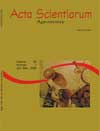<b>Soil nitrogen and crop residues in bean development on no-tillage system in direct sowing</b> - DOI: 10.4025/actasciagron.v25i1.2447
Abstract
The aim of this study was to evaluate the side dressing nitrogen effect, in common bean, Phaseolus vulgaris L., on no tillage system under different crop residues. The used design consisted of randomized blocks in a split-plot scheme with four replications. Crop residues, number of days for the bloom, dry matter weight, stand, number of pod and seeds per plant, number of seeds per pod, weight of 100 seeds, N in leaves and seeds and yield were evaluated. The results showed that: the Crotalaria juncea and black velvet bean (Mucuna aterrima) proved the best crop residue, and the Crotalaria juncea had the highest dry matter weight; there was not crop residues influence under common bean yield; the side dressing nitrogen application increased the production. However, even where there was not N application, the yield was higher to 2000 kg ha-1, therefore an economic analysis is an important factor in making decision.Downloads
Download data is not yet available.
Published
2008-04-23
How to Cite
Silva, T. R. B. da, Arf, O., & Soratto, R. P. (2008). <b>Soil nitrogen and crop residues in bean development on no-tillage system in direct sowing</b> - DOI: 10.4025/actasciagron.v25i1.2447. Acta Scientiarum. Agronomy, 25(1), 81-87. https://doi.org/10.4025/actasciagron.v25i1.2447
Issue
Section
Agronomy
DECLARATION OF ORIGINALITY AND COPYRIGHTS
I Declare that current article is original and has not been submitted for publication, in part or in whole, to any other national or international journal.
The copyrights belong exclusively to the authors. Published content is licensed under Creative Commons Attribution 4.0 (CC BY 4.0) guidelines, which allows sharing (copy and distribution of the material in any medium or format) and adaptation (remix, transform, and build upon the material) for any purpose, even commercially, under the terms of attribution.
2.0
2019CiteScore
60th percentile
Powered by 

2.0
2019CiteScore
60th percentile
Powered by 



















































